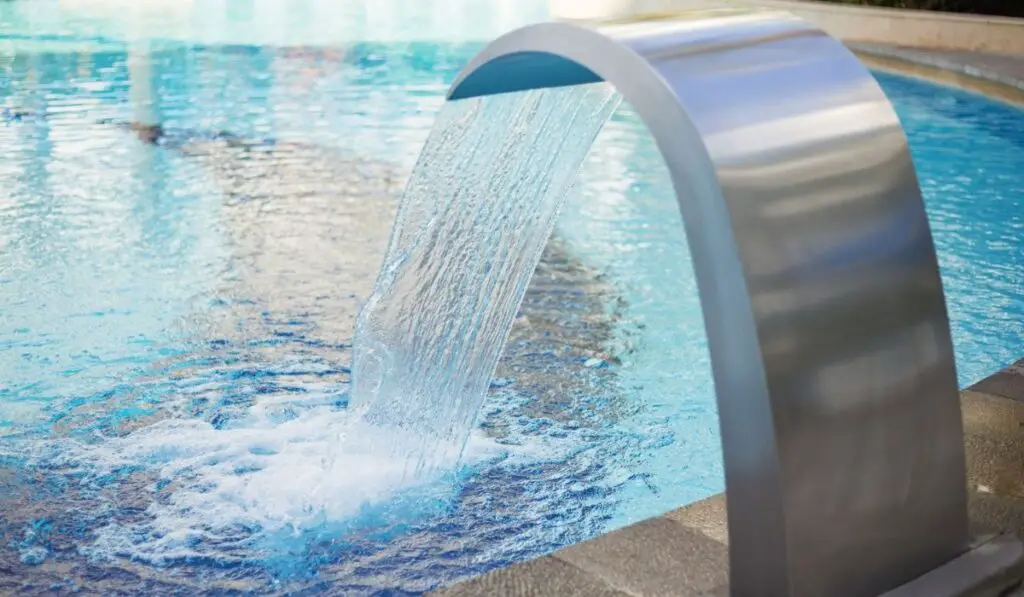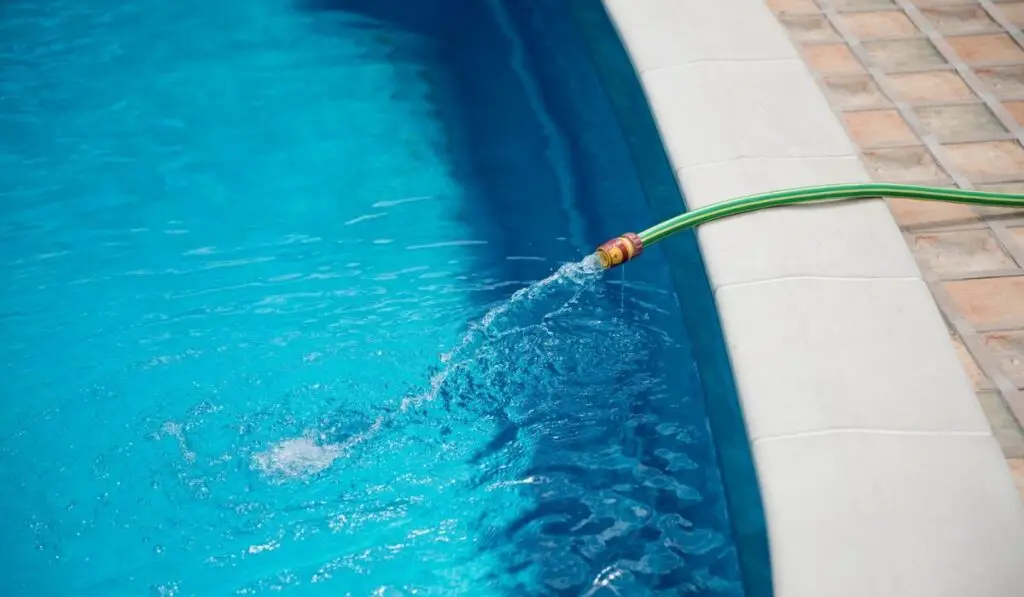It’s summertime, and that means it’s time to hit the pool! Unfortunately, you’ll need to fill your pool before you can dive in and enjoy the refreshing water. So, how long will it take to fill up a 1,000-gallon pool?
The time it takes to fill up an empty pool depends on several factors, including water pressure, size, location, and more. Pools with a capacity of 1,000-5,000 gallons should generally take less than a day to fill up. An empty 15,000-gallon pools, meanwhile, might take a few days.
Nonetheless, filling up a pool isn’t as simple as just turning on the hose and waiting a few hours. There are several steps that you need to be aware of in order to get it right. Let’s take a closer look at how much time you’ll need to fill your pool and how to go about it properly.
Average Length of Time to Fill a 1,000-Gallon Pool

Filling an empty swimming pool with water can be a lengthy process depending on the size of the pool. Smaller pools of less than 5,000 gallons can easily be filled in less than a day. For example, an empty 1,000-gallon pool might take just an hour and a half or two hours to completely fill up.
There are a lot of factors that impact the time it takes to fill a swimming pool. However, water pressure is one of the most significant elements to consider. The average garden hose has a gallon per minute (GPM) rating between 9 and 17.
However, the process and timeframe will differ depending on the circumstances. Your mileage will also vary if you opt for city water or water deliveries.
What Is the Process of Filling a Pool?
There are a few more steps to filling up an empty swimming pool than simply turning on the hose and waiting. You’ll need to prepare your pool, clean it, and make any adjustments as needed.
Routine Maintenance
You’ll need to complete your pool’s routine maintenance before you can start filling it with water, since routine maintenance is typically easier when the pool is empty. You’ll need to reconnect any pumps, heaters, fill valves, and lights if you’re filling your pool up after winterizing.
You might need to prepare the skimmers and reinsert plugs or fittings. Be sure to follow all of your pool’s instructions and guidelines for the best results.
Cleaning Your Pool
You’ll want to thoroughly clean your pool before filling it with water. You should scrub the pool’s liner and remove any algae or bacteria that are starting to emerge. Remove any sticks, leaves, or other debris.
You might need to use special pool equipment such as vacuums or brushes, depending on the situation. This is also an excellent time to check for any damages to the liner or interior of your pool.
Fill Your Pool
After maintenance and cleaning, you can start filling your pool with water. You can use a standard garden hose connected to an outdoor faucet. Make sure the hose is flexible and that it won’t become dislodged or tangled. Be sure to prevent any lawnmowers, kids, or pets from slowing the process.
Simply turn the hose on and allow the pool to fill. Sit back, relax, and wait until the pool reaches your preferences. You might want to check the water level throughout the process to ensure nothing is damaged or going awry.
The filling process might take a few hours or a few days; it’ll depend on the size of your pool. It’s best to turn the water off overnight and when you’re away from home.
Saltwater pools have some additional steps. You’ll need to add salt and stabilizers and then circulate the water with a pump. Use a pool test kit (on Amazon) to ensure the chemicals are properly adjusted. Be sure to follow all instructions and guidelines for the best results.
Can I Fill a Pool Myself?
Yes, it’s possible to fill a pool without professional services. However, there are a few things to keep in mind. Filling up a pool by yourself is straightforward but it can still be pricey, depending on the location.
Limited water supplies, droughts, and natural disasters can result in extra fees. Extra fees and premiums are likely if the demand for water has led to water rationing in your location.
Your costs will also depend on local water rates. You might end up paying higher fees depending on the situation. In some cases, you can be charged sewage fees if you’re on municipal sewage.
You should consult your local utility center and find out how much you’ll have to pay per gallon. The total might surprise you, but it’s usually less expensive than using water delivery services.
How Much Will It Cost to Fill My Pool?

The costs to fill up your pool will vary depending on the size, location, and situation. On average, homeowners pay somewhere between $4 and $10 per thousand gallons of water. However, you might pay somewhere between $75 to over $200, depending on the size of your pool and the utility costs.
For instance, $1 will pay for around 129 gallons of water in the United States. With these rough numbers, we can estimate the following expenses:
- 1,000-Gallon Pool: $7.75
- 5,000-Gallon Pool: $38.84
- 10,000-Gallon Pool: $77.68
- 15,000-Gallon Pool: $111.11
- 20,000-Gallon Pool: $155.36
You can consult your city’s water and sewer department for the most accurate information.
The rates will also depend on whether you’re using a well pump or not. You might need to know your pump manufacturer, wattage, and model if you’re using a well. Extra premiums due to droughts, limited water supplies, or natural disasters can also impact the total costs.
How to Maintain Your Pool
The process might seem like a pain, but pool maintenance is a crucial step that can’t be neglected. Maintaining a pool is necessary for keeping it clean, safe, and long-lasting. The steps might vary depending on your specific situation, but here are a few to get you started.
Remove Debris
Start by skimming out any twigs, leaves, or other debris from the water’s surface. If you wait too long, debris can sink to the bottom of the pool floor, causing hassles in the process. If you don’t vacuum, the debris will stay there, causing an unsightly appearance.
You can use a simple pool skimmer (on Amazon) to fish out any bugs, twigs, or debris. You can also utilize automatic skimmers to speed up the process.
Brush and Vacuum
Now that you’ve fished out all the debris, it’s time to clean the pool floor, walls, and stairs. Although these parts might look clean, it’s possible that they picked up contaminants or pollutants that you can’t see. If you skip brushing and vacuuming, you might have a green or cloudy white pool in the future.
After you’ve finished scrubbing the interior of your pool, connect your vacuum to the skimmer and start cleaning the pool floor. Be sure to vacuum across the full length of the pool. If you have an automatic pool cleaner, you can simply place it in the water and let it do it’s job.
If you don’t have a pool vacuum, you can use your brush instead. Push any debris on the pool floor towards the main drain using the brush. The drain will suck up the debris and send it through the filter.
Test the Water and Adjust the Chemicals
Now that everything’s all clean, you’ll need to test the pool water. Testing the water and adjusting it accordingly is the most important step. Keeping your water clean is the best way to prevent green water, cloudy surfaces, and other contaminants.
After testing, you’ll have a clear idea of which chemicals need adjustment. Generally speaking, starting with Total Alkalinity will help stabilize the pH levels. Afterward, you’ll want to check the pH, Calcium Hardness, and Chlorine/Sanitizer.
Clean the Pump Filter
Now you can clean out the pump filter. You’ll want to shut the system off and close the skimmer valve beforehand. This ensures the water is held in place so the system won’t need to be re-primed when it’s turned on again. Unscrew the pump cover, remove the basket, and empty it out into your garbage.
Add Chlorine to the System
You’ll need to add chlorine if your pool has a chlorinator. A chlorinator is a tube-like tank that’s typically next to the filter. You have several different options for adding chlorine to your pool, and the best solution will depend on your circumstance.
Be sure to read the package thoroughly and calculate how much chlorine your pool requires. Adding too much chlorine or too little can be dangerous and cause unnecessary complications.
After you’ve finished adding the chlorine, you’ll want to check the water level and refill it if it’s less than halfway up the skimmer’s mouth.
